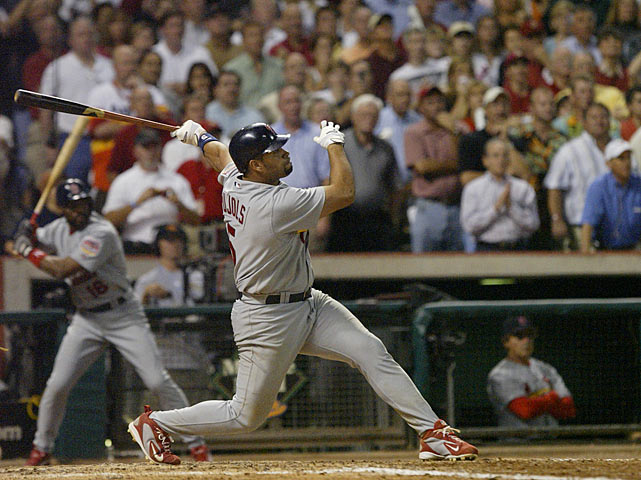It's not often that a home run makes not one but two cities shake. On Oct. 17, 2005, Albert Pujols did just that with a mammoth blast off Houston closer Brad Lidge. Pujols didn't hit the bull. He did Crash Davis one better. He hit the train tracks on top of the stadium, nearly sending the baseball out of the stadium.
I remember where I was. I was sitting in my apartment in Florissant and formulating a wake for the 2005 Cardinals. It was a great run and season. Sadly, it was going to be the end of the Manual Scoreboard in Busch Stadium, which was being replaced with the new stadium across the street. The Cards were done, but my work as an employee on the previously mentioned scoreboard was also done.
Things were looking dreary. The Cards were down 4-2 and there were two runners on. I remember David Eckstein starting that rally with a single. He was a pesky one. Edmonds continued it with a walk. Lidge was known as the "don't even think about it" guy to Cardinals fans. The Birds were zero for the century against him. He converted so many saves against St. Louis that Mariano Riveria looked hittable compared to him.
Lidge converted 42 saves that season and compiled an illegal 2.19 fielding independent pitching mark(FIP). Hitters dreamed about getting to him. It was like planning a vacation that you'd never take. In the National League Division Series against Atlanta, the cracks in Lidge's facade were showing. He walked four in four innings while holding the Braves scoreless. He converted three saves against the Cardinals in the NLCS, but the Pujols blast is what people remember.
They remember the Pujols three-run home run halfway towards South America more than the eventual outcome, which was Roy Oswalt turning the lights off on Busch Stadium a couple days later. Sometimes, home runs last longer in history than series wins.
It was prime rib Alberto Jose Pujols. He took a first pitch strike before sending the next pitch over the trains. When it happened, I shot off the floor and hooked a left turn around my apartment living room, past the kitchen, and into the wall located in the middle of the place. I got up and couldn't believe it. My wife had put the Cards to bed a half hour earlier.
The place was quiet and then it was loud. That's the power of sports. It can raise the volume in a room and a life. Kael Lane in north St. Louis County got loud. I drove up to a nearby gas station to buy an obligatory fountain soda. I poured Jack Daniels in it and wandered the streets like Bukowski with a notepad in New Orleans. It was beautiful.
Pujols had broken Lidge and extended a series. In the World Series, Lidge would be lit up for a home run, two earned runs, and four hits in 3.2 innings. The effect lasted for two more seasons, as Lidge's earned run average rose and his invincibility was gone.
The mental aspect of sports can't be denied and this is a prime example. The city of Houston and everyone in the ballpark and thought the series was over. Andy Petitte talked about it years later. The effect it had on the dugout and the revered wonder that sifted throughout the Astros clubhouse.
And no one felt it more than the closer. He looked like a 1,000 piece puzzle shattered on a patch of dirt. It was sad and wonderful at the same time, nearly as bittersweet as Ryan Howard's career rupturing along with his Achilles years later.
It took a new team and city for Lidge to become great again, and he did in 2008 with 41 saves and a World Series title with Philadelphia. His last playoff action came against the Cardinals in that fateful 2011 National League Division Series. Overall, Lidge's postseason ERA would be 2.18 in just over 45 innings. The home run lingers though.
Eleven years later and Pujols is slowly decaying in Los Angeles and Lidge is out of baseball. In St. Louis, that memory never dies. It illuminates like a street light when you get close to it in your head. Check it out and try not to get chills all over again.

